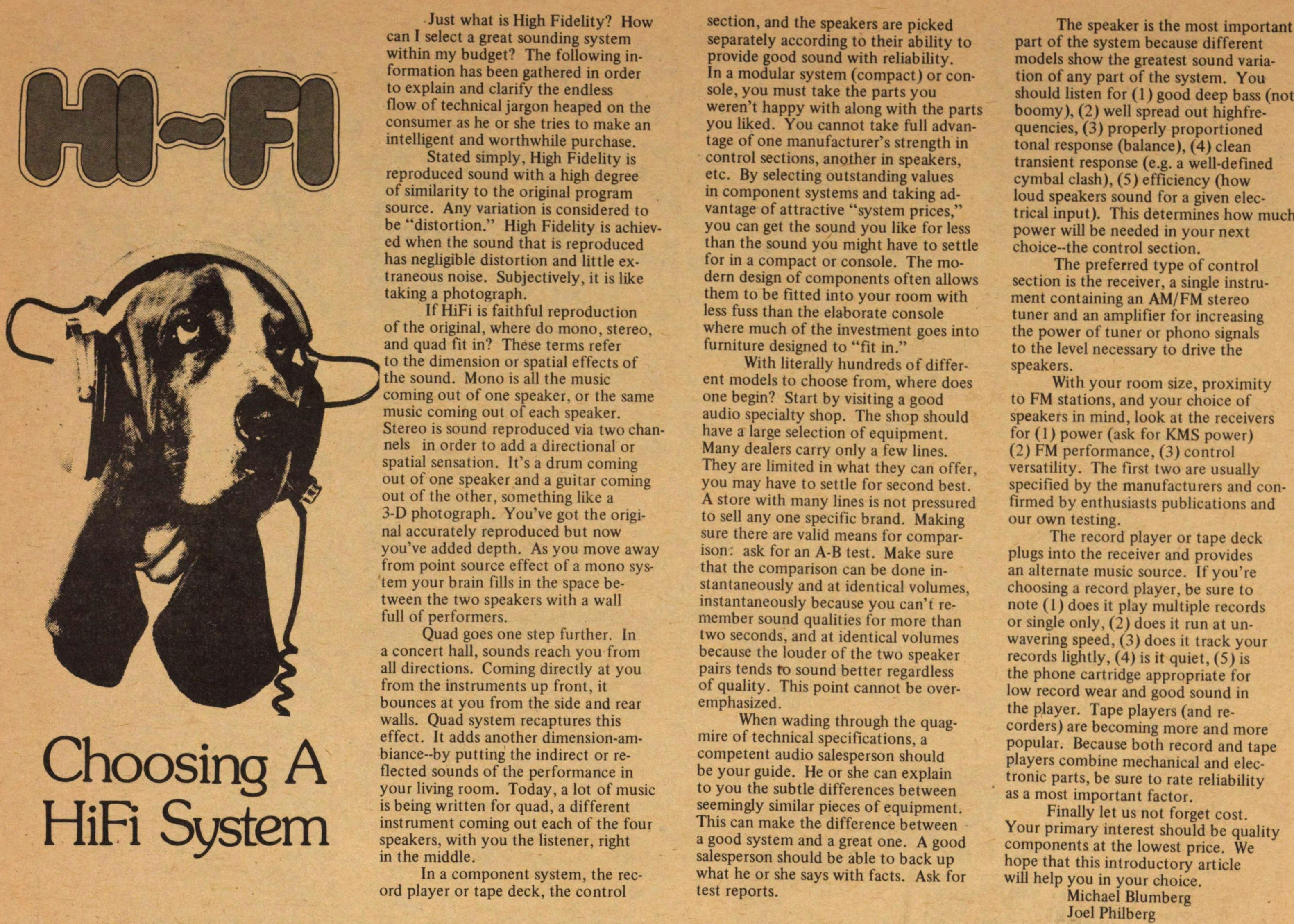Hi-fi

HI-FI
Choosing A HiFi System
Just what is High Fidelity? How can I select a great sounding system within my budget? The following information has been gathered in order to explain and clarify the endless flow of technical jargon heaped on the consumer as he or she tries to make an intelligent and worthwhile purchase.
Stated simply, High Fidelity is reproduced sound with a high degree of similarity to the original program source. Any variation is considered to be "distortion." High Fidelity is achieved when the sound that is reproduced has negligible distortion and little extraneous noise. Subjectively, it is like taking a photograph.
If HiFi is faithful reproduction of the original, where do mono, stereo, and quad fit in? These terms refer to the dimension or spatial effects of the sound. Mono is all the music coming out of one speaker, or the same music coming out of each speaker. Stereo is sound reproduced via two channels in order to add a directional or spatial sensation. It's a drum coming out of one speaker and a guitar coming out of the other, something like a 3-D photograph. You've got the original accurately reproduced but now you've added depth. As you move away from point source effect of a mono system your brain fills in the space between the two speakers with a wall full of performers.
Quad goes one step further. In a concert hall, sounds reach you from all directions. Coming directly at you from the instruments up front, it bounces at you from the side and rear walls. Quad system recaptures this effect. It adds another dimension--ambiance--by putting the indirect or reflected sounds of the performance in your living room. Today, a lot of music is being written for quad, a different instrument coming out each of the four speakers, with you the listener, right in the middle.
In a component system, the record player or tape deck, the control section, and the speakers are picked separately according to their ability to provide good sound with reliability. In a modular system (compact) or console, you must take the parts you weren't happy with along with the parts you liked. You cannot take full advantage of one manufacturer's strength in control sections, another in speakers, etc. By selecting outstanding values in component systems and taking advantage of attractive "system prices," you can get the sound you like for less than the sound you might have to settle for in a compact or console. The modern design of components often allows them to be fitted into your room with less fuss than the elaborate console where much of the investment goes into furniture designed to "fit in."
With literally hundreds of different models to choose from, where does one begin? Start by visiting a good audio specialty shop. The shop should have a large selection of equipment. Many dealers carry only a few lines. They are limited in what they can offer, you may have to settle for second best. A store with many lines is not pressured to sell any one specific brand. Making sure there are valid means for comparison: ask for an A-B test. Make sure that the comparison can be done instantaneously and at identical volumes, instantaneously because you can't remember sound qualities for more than two seconds, and at identical volumes because the louder of the two speaker pairs tends to sound better regardless of quality. This point cannot be overemphasized.
When wading through the quagmire of technical specifications, a competent audio salesperson should be your guide. He or she can explain to you the subtle differences between seemingly similar pieces of equipment. This can make the difference between a good system and a great one. A good salesperson should be able to back up what he or she says with facts. Ask for test reports.
The speaker is the most important part of the system because different models show the greatest sound variation of any part of the system. You should listen for (1) good deep bass (not boomy), (2) well spread out highfrequencies, (3) properly proportioned tonal response (balance), (4) clean transient response (e.g. a well-defined cymbal clash), (5) efficiency (how loud speakers sound for a given electrical input). This determines how much power will be needed in your next choice-the control section.
The preferred type of control section is the receiver, a single instrument containing an AM/FM stereo tuner and an amplifier for increasing the power of tuner or phono signals to the level necessary to drive the speakers.
With your room size, proximity to FM stations, and your choice of speakers in mind, look at the receivers for (1) power (ask for KMS power) (2) FM performance, (3) control versatility. The first two are usually specified by the manufacturers and confirmed by enthusiasts publications and our own testing.
The record player or tape deck plugs into the receiver and provides an alternate music source. If you're choosing a record player, be sure to note (1) does it play multiple records or single only, (2) does it run at unwavering speed, (3) does it track your records lightly, (4) is it quiet, (5) is the phone cartridge appropriate for low record wear and good sound in the player. Tape players (and recorders) are becoming more and more popular. Because both record and tape players combine mechanical and electronic parts, be sure to rate reliability as a most important factor.
Finally let us not forget cost. Your primary interest should be quality components at the lowest price. We hope that this introductory article will help you in your choice.
Michael Blumberg
Joel Philberg
Article
Subjects
Freeing John Sinclair
Old News
Ann Arbor Sun